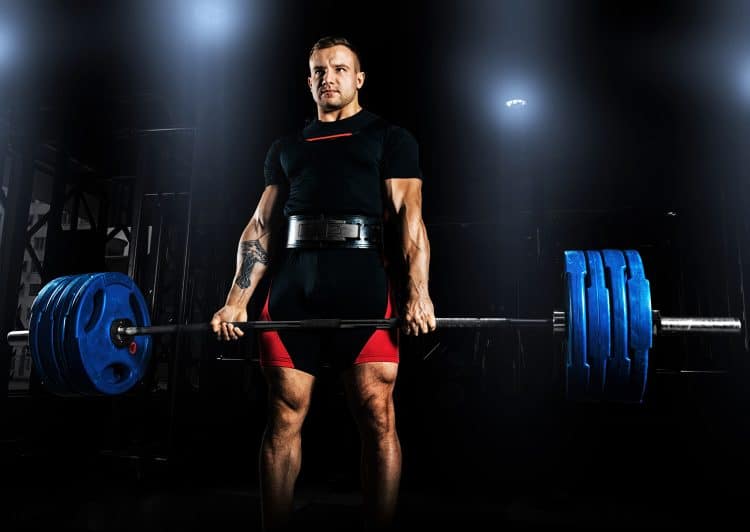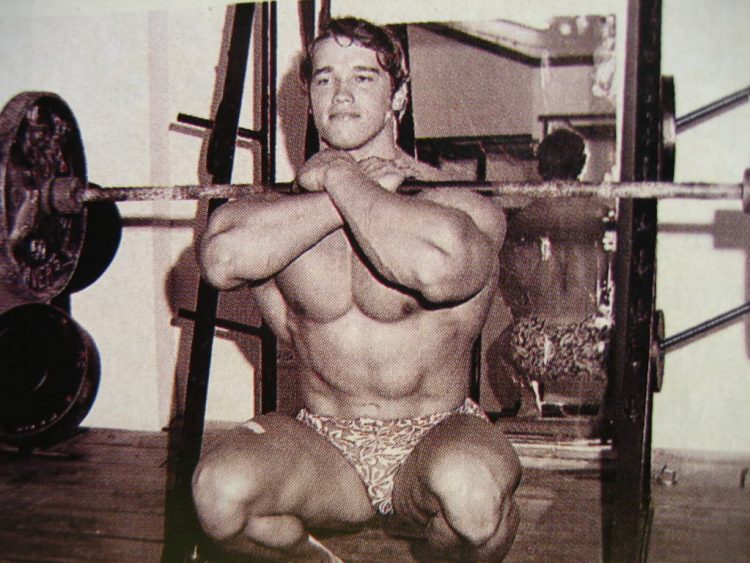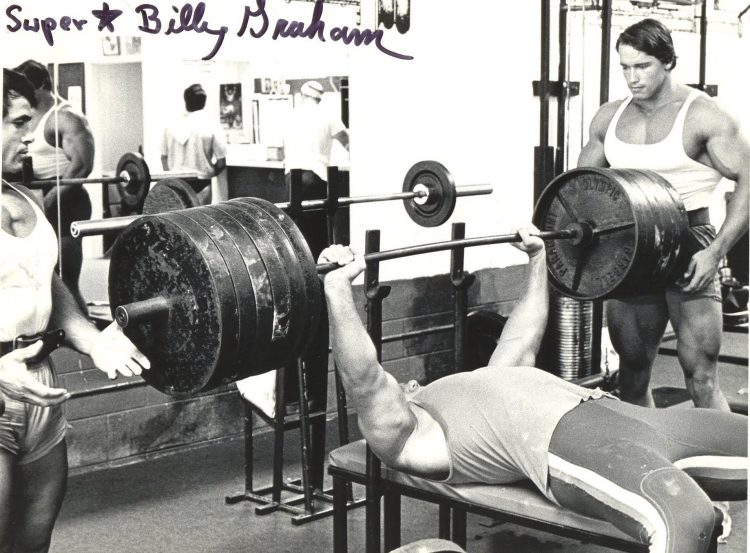Most bodybuilders follow a body part split routine. This is where you train different muscles on different days. You literally split your body down into parts so you can spend more time on each one.
For example:
- Monday – Chest
- Tuesday – Back
- Wednesday – Rest
- Thursday – Legs
- Friday – Shoulders, and Arms
- Saturday – Rest
- Sunday – Rest
There are dozens of different training splits to choose from, and each one can be customized by varying the exercises, sets, and reps you perform.
All split routines have the potential to work, but the best one is whatever you can stick to and do consistently. For example, if you plan on training six times a week but only manage to do four workouts, your chosen split won’t produce good results. In contrast, a more straightforward split may mean you never miss a workout, which will be far more effective.
In this article, we’re going to compare and contrast two very popular split routines – the Arnold split and the push-pull-legs (PPL) split – so you can determine if either of these plans is right for you.
What Is the Arnold Split?
The Arnold split is named after bodybuilding legend Arnold Schwarzenegger. It was one of his favorite workout routines and one he used frequently to build his world-famous physique.
Level Up Your Fitness: Join our 💪 strong community in Fitness Volt Newsletter. Get daily inspiration, expert-backed workouts, nutrition tips, the latest in strength sports, and the support you need to reach your goals. Subscribe for free!
However, it’s worth noting that Arnie didn’t use this split all the time and often varied his workouts. For example, he also trained using a full-body program, which he called the Golden Six Routine.
Anyway, the Arnold split divides your muscles into three workouts. Workout one focuses on your chest and back, while the second workout trains your shoulders, biceps, and triceps. The third workout is dedicated to the legs.
Beginners should limit themselves to doing each workout once per week, but more experienced lifters can do each workout twice.
The Arnold split is a form of agonist/antagonist training as muscle groups are arranged in opposing pairs. This is good for push/pull supersets and ensures that the muscles on the front of your body are as well developed as those on the back.
This table shows how the Arnold split divides your muscle groups:
| Workout 1 | Workout 2 | Workout 3 |
| Chest | Shoulders | Quadriceps |
| Back | Biceps | Hamstrings |
| Triceps | Glutes | |
| Calves | ||
| Abs |
Sample Arnold Split Routine
While there is nothing to stop you from filling in the blanks and writing your own Arnold split routine, here’s one to save you the bother!
Workout #1 – Chest and Back
- Bench press
- Pull-up
- Incline dumbbell bench press
- Seated row
- Cable fly
- Lat pulldown
- Dumbbell pullover
Do each exercise for 2-4 sets of 8-12 reps.
Workout #2 – Shoulders, Biceps, and Triceps
- Arnold press
- Dumbbell lateral raise
- Barbell curl
- EZ bar skull crusher
- Preacher curl
- Cable triceps pushdown
Workout #3 – Legs and abs
- Barbell squats
- Leg press
- Leg extensions
- Leg curls
- Seated calf raise
- Standing calf raise
- Cable crunch
- Hanging knee raise
Do each exercise for 2-4 sets of 8-12 reps. Beginners should do each workout once per week, while more experienced lifters can do each one twice to total six workouts.
Arnold Split Pros and Cons
Not sure if the Arnold split is the right training routine for you? Consider these pros and then decide!
Pros
- Great for building bigger arms – your biceps and triceps get trained once directly and once indirectly every three workouts. Repeat the sequence one more time, and you’ll put a real emphasis on arm training, which should enhance arm growth.
- A balanced program – push and pull movements are grouped together, e.g., chest and back, which should promote muscular balance for a more pleasing physique, better posture, and fewer muscle imbalances and injuries.
- A customizable training split – you can train three or six times per week with the Arnold split. This means it’s suitable for beginner and intermediate/advanced lifters.
- Two leg workouts – if you do the six-workout version of the Arnold split, you’ll do two leg workouts per week. Given that many lifters have underdeveloped legs, this is a significant advantage over many other programs where the legs are only trained once per seven days.
- A proven workout method – the Arnold split has been around since the early 70s and is still in use today. This strongly suggests that it works. If the Arnold split had been ineffective, it would have disappeared years ago.
Cons
There are also a few drawbacks to the Arnold split, so make sure you consider these drawbacks before starting this training plan:
- Fatigue between upper body training days – with the Arnold split, you train your chest and back one day and your shoulders and arms the next. That means several muscle groups are trained two days in a row, which may impair your workout performance on the second day.
- The chest and back workout is HUGE! – chest and back are big muscle groups that need plenty of exercises and sets to develop fully. As such, this session is going to be long and tiring. It may be too much for beginners and anyone unused to such lengthy workouts.
- Too much arm training? – while some people may see all that arm work as an advantage, it could also be a disadvantage. Two direct and two indirect arm workouts could leave your arms overdeveloped, overtrained, or just tired and sore.
What is the PPL Split?
PPL stands for push, pull, and legs, which refers to the order of your workouts and what type of exercises you’ll be doing each day. This is a popular training approach and is often used as an alternative to the Arnold split.
Like the Arnold split, the PPL split can involve three or six workouts per week, which means it’s suitable for beginners and more experienced lifters.
As the name implies, exercises are grouped according to the main movement they involve. For example, pushing exercises mostly hit the chest and shoulders, while pulling exercises primarily train the back and biceps.
This table shows how the PPL split divides your muscle groups:
| Push workout | Pull workout | Leg workout |
| Chest | Back | Quadriceps |
| Shoulders | Biceps | Hamstrings |
| Triceps | Glutes | |
| Calves | ||
| Abs |
Sample PPL Split Workout
Here is a sample PPL program to try. Beginners should do each workout once, while more experienced lifters can do them twice for six workouts per week.
Push Workout
- Bench press
- Incline dumbbell press
- Dumbbell fly
- Seated dumbbell shoulder press
- Dumbbell lateral raise
- Triceps pushdown
- Triceps dips
Do each exercise for 2-4 sets of 8-12 reps.
Pull Workout
Do each exercise for 2-4 sets of 8-12 reps.
Leg Workout
- Front squat
- Romanian deadlift
- Walking lunge
- Standing calf raise
- Donkey calf raise
- Weighted plank
- Side cable crunch
Do each exercise for 2-4 sets of 8-12 reps.
PPL Split Pros and Cons
Not sure if the PPL split is a good fit for you? Consider these pros and cons, and then make your decision!
Pros
- A balanced program – dividing exercises into pushes and pulls means you should end up training all muscle groups fairly equally, even though they’re trained on separate days.
- Less warming up required – the push and pull workouts involve doing lots of similar exercises in a row. As such, you won’t need much warming up after the first movement.
- Easy to plan – putting a PPL workout plan together is relatively straightforward. Do presses one day, rows and pulldowns the next, and then legs on the third day. There is a clear division between exercises and muscle groups.
- A flexible training split – you can do PPL once or twice a week according to your training experience, time available, and energy levels. In contrast, many other training splits are far less flexible and not as easy to modify.
- Two leg workouts per week – as with the Arnold split, if you do two cycles of PPL per week, you get to train your legs twice every seven days. This is rarely a bad thing!
- A tried and tested training program – like the Arnold split, the push-pull-legs workout split has been around for a long time. As such, it’s safe to say it’s proven and effective.
Cons
Of course, there are a couple of PPL drawbacks to consider too:
Level Up Your Fitness: Join our 💪 strong community in Fitness Volt Newsletter. Get daily inspiration, expert-backed workouts, nutrition tips, the latest in strength sports, and the support you need to reach your goals. Subscribe for free!
- The push workout is pretty long – training your chest, shoulders, and triceps in one session means that session is going to be quite lengthy. Expect to spend at least 90 minutes on this workout, while the back and biceps session will be considerably shorter.
- Energy levels will decrease as you progress through each workout – doing chest, shoulders, and triceps means doing lots of similar exercises back to back. By the time you get to the triceps exercises, your muscles will be tired, and you may find you are unable to train as hard as you want to. The same is true for doing biceps after back.
- Less arm training – where the Arnold split means you can train your arms four times per week, twice directly and twice indirectly, the PPL split only hits your arms twice. This may be a drawback if you want to emphasize your biceps and triceps.
Arnold Split vs. PPL – FAQs
Got a question about the Arnold vs. PPL split? Don’t worry – we’ve got the answers you seek!
1. Which split is better for bodybuilders?
The Arnold and PPL split are both ideal for bodybuilders. These two plans are very similar and provide a good balance between training volume, frequency, and recovery. The Arnold split involves a little more arm and shoulder training, so it may be a better choice if you want to emphasize those areas.
Bottom line – both of these splits can increase muscle mass, providing you train hard, get plenty of sleep, eat well, and don’t skip workouts.
2. Which of these splits is better for athletes?
Strength training can improve performance in most sports. However, there is a significant difference between training for muscle size, i.e., bodybuilding, and training to be better at sports. Sports training tends to be much more functional and activity-specific.
As such, neither of these training splits is ideal for athletes. Instead, you should focus more on building strength, power, and on athletic skills and movements than specific muscles.
3. Are these training splits suitable for beginners?
Most beginners should start with full-body workouts, where all major muscles are trained three times per week. After a few months of consistent training, they can progress to something like an upper/lower body split, where each muscle is trained twice per week but with more volume.
After that, our beginner will have progressed to early intermediate status and may be ready for a more demanding split, such as a four-way split, the Arnold split, or a PPL workout.
While a beginner CAN follow an Arnold or PPL split, they’ll probably do better on a less arduous program – at least until they’ve been training for a year or so.
4. Are the Arnold and PPL splits better for bulking or cutting?
Bulking and cutting are really a matter of diet more than training. To bulk, meaning to gain weight and build muscle mass, you must increase your calorie intake above maintenance to fuel your workouts and muscle growth. Your workouts must be hard and frequent enough to stimulate hypertrophy.
In contrast, you need to create a calorie deficit by eating less than usual to cut and get ripped. This will force your body to burn fat for fuel. Your workout will increase your caloric expenditure while preserving muscle mass.
As such, both splits can be used for cutting or bulking, and what really matters is your diet.
Read more about bulking vs. cutting here.
5. Are the Arnold and PPL splits suitable for powerlifters?
Powerlifters tend to train differently from bodybuilders. Rather than focus on individual muscles, they work on improving their performance in the competition lifts – the squat, bench press, and deadlift. Because of this, neither the Arnold nor PPL split is ideal for powerlifters.

More often, powerlifters follow a routine like this:
- Workout 1 – squat plus squat assistance exercises
- Workout 2 – bench press plus bench press assistance exercises
- Workout 3 – deadlift plus deadlift assistance exercises
- Workout 4 – bench press plus bench press assistance exercises
As you can see, this is a very different training program from either the Arnold or PPL Split.
6. How often should I change my training split?
Many exercisers change their training split every few months. They do this to keep their workouts fresh, enjoyable, and productive, but this may not be necessary.
In reality, you don’t need to change your training split very often if you bother changing it at all. Instead, you need to vary your exercises and set/rep scheme from time to time to ward off plateaus and prevent boredom.
So, if you’ve found a split you enjoy and that fits neatly into your weekly schedule, feel free to stick with it for the foreseeable future. However, make sure you change exercises every 6-8 weeks and try different set and rep schemes to maintain workout productivity.
7. How soon until you see results with the Arnold or PPL training split?
Both of these splits can be effective, especially for intermediate and advanced lifters. However, intermediate and advanced lifters have largely finished enjoying their fast “newbie gains,” so even though these are great plans, they probably won’t produce rapid results.
The closer you are to your genetic limit for building muscle and strength, the slower you tend to progress. In contrast, new exercisers make rapid gains because they’re far from their genetic potential.
So, while both the Arnold and PPL splits can be productive, it’s impossible to say how soon you’ll start to see results. It could be a few weeks, but it could also be a couple of months. It all depends on your training status, your diet and attention to recovery, and how genetically predisposed you are to gaining muscle.
That said, if you aren’t seeing much in the way of progress, even after a few months, it could be that these training splits are not the best option for you.
8. How can I choose between the Arnold and the PPL training split?
There comes the point where, after doing your research, you’ll need to choose either the Arnold split or the PPL plan. If you are still undecided, the best thing to do is try them both and see which one you prefer.
So, do the Arnold split for 6-8 weeks, evaluate your progress, and then do the PPL split for another 6-8 weeks. Again, assess your progress and see which one worked best. After your experiment, it should be more obvious which one is right for you.
However, it’s worth pointing out that both of these training splits are very similar, and there really isn’t much to choose between them. Either one should help you build muscle.
Arnold vs. PPL Split – Closing Thoughts
Many lifters suffer from something called paralysis by analysis. They get so hung up on the micro-details of their workouts that they never really get into a productive training cycle. Instead, they hop from program to program and end up undermining their progress as a result.
The truth is that things like exercise selection, training frequency, and even your workout split don’t really matter that much. Instead, the main drivers of progress are intensity and consistency.
In other words, providing you train hard and often enough, your body will adapt by getting stronger and more muscular.
The Arnold and the PPL split both work, but they are not the only way to organize your training week. So, don’t feel you are missing out if you only have time for four (or even two) workouts per week. Ultimately, any split will work if you hit it hard, and don’t miss workouts.












